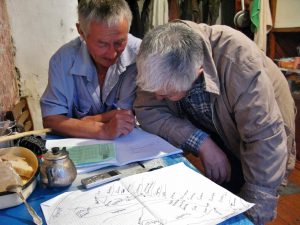Many geographical features have their own unique names – toponyms. For the indigenous peoples of the world and those still leading a traditional way of life, place-names serve not only as a means of marking space and orienting yourself in it, but also as the symbolic conceptualization of space by means of stories (narratives) that reveal the essence of place-names. Toponyms can be inserted into mythological storylines that tell us about the times of the first ancestors and culture heroes (mythological characters), and their use helps give spaces cultural significance. In the mythology of the Ewenkis, for example, the Trickster Fox gives names to places and uses them to confuse human beings. According to the mythology of the Tlingit of Alaska, Raven is not only the creator of geographical objects, but also responsible for giving them their names. This once again emphasizes the fact that toponyms are far more than mere points on a map. Place-names are also a way of “managing” space through the politics and practice of applying names and placing these toponyms on geographical maps. The world’s indigenous peoples display great diversity in the forms they use for both naming objects and representing space using mapping tools that are not limited to the methods of standard cartography (see, for example, the maps of the Chukchi or the Inuit). They can include not only maps of territories as such, made on various surfaces including paper, hide and birch bark, but also cosmological maps, imagery on shamanic costumes and drums, and mythological stories and narratives that function as an alternative means of cartography. It is generally assumed that indigenous peoples transmit toponyms unchanged from generation to generation. However, our own field materials collected among the Ewenkis of Siberia reveal that toponyms are not only reproduced and passed down from generation to generation, but also modified and invented in the here and now. In other words, beside the traditional notion of place-names among indigenous peoples as something unchanging and ancient (though many are), there is also a dynamic space-naming model in operation among nomadic communities. This discovery demands that we take a number of new methodological approaches to the ways in which researchers and community members themselves can document, preserve, and use place-names. Our project for a digital toponymic platform is an attempt to open up access to toponymic data and enable indigenous people to upload and share toponymic information on their own initiative. Our specially-designed toponymic GIS platform will facilitate the mapping of place-names pertaining to any geographic feature (from rivers and lakes to areas of tundra and hills), as well as sketch maps and other related materials, including the histories of places and photographs. We call it a “live” platform to emphasize the dynamic nature of toponymic knowledge, and stress its relevance in the present. The idea of developing a GIS platform came to us while we were doing field work in Siberia. Firstly, some of our indigenous participants had been gathering information about place-names and collecting hand-drawn maps for a long time. Secondly, we wanted to make the materials we had collected available to members of the communities we had been researching among. Thirdly, some toponyms change over time and knowledge about them is inevitably lost. Toponymic atlases do not let you see the dynamics of these changes. Finally, modern GIS technologies and official maps fail to reflect the fullness of indigenous knowledge about place-names. The names they feature may often be inaccurate or misspelled.

❰ The aim of this project is to reveal the potentially deep and complex system of knowledge about place-names to be found among indigenous peoples, primarily the Ewenki. With this in view, it is thus not limited to place-names as such, but also includes other information such as the relationships between place-names and geographical features, practices, myths and narratives, as well as data on changes in toponyms or shifts in their meanings over time ❱
It should be noted that the GIS platform is more than simply a storehouse for place-names – it is also a tool for exchanging toponymic data. In order to enrich the database of the GIS platform, we have posted methodological guidelines to help researchers and community members collect toponymic information, along with detailed instructions for how to add toponymic data to the platform. Due to the fact that some information may be protected by copyright, the site contains information on the rules for using materials from this project. The GIS platform enables: ➤ Toponymic data to be stored in an open accessible form ➤ Compilation of the most complete corpus of toponymic data to date, including by such means as the use of archival materials. ➤ Granting indigenous communities full access to their toponymic data. ➤ Uploading and sharing knowledge about place-names. Indigenous community members can select for themselves what information they would like to add to the map, as well as access archival and contemporary materials on toponymy. ➤ The integration of vernacular and alternative forms of cartography, such as hand-drawn maps and the oral histories of particular places, with GIS technology. ➤ Comparative studies of place-name changes, the collection and study of toponymic information both synchronously and diachronically, comparing different regions with respect to the distribution of certain toponyms or categories of toponyms. ➤ Minimizing the researcher’s presence in the collection of toponymic data. ➤ Adaptation of the platform for the toponymic systems of other indigenous communities More about the project and the GIS platform can be found here. For the further study and comparison of different toponymic systems, we have set up a section of the website with links to academic research in the field of indigenous toponymy and cartography and alternative cartographic resources. The section on events related to the project will be updated regularly. Materials on the website are published under the CC BY-NC 4.0 license. The project was created with support from the Society for Endangered Languages.




